Summarised, the Dragon’s Back Race was a week running the ‘spine’ of Wales in a week of particularly intense heat. This week-long adventure was interspersed with lasting memories and friendships forged in the shared enjoyment of the mountains of Wales (and the hardships we endured).
The Dragon’s Back Race (Ras Cefn y Ddraig in Welsh) is a 380km, 6-day ultra running journey through Wales covering 17,400m of total height gain. It’s an extremely tough and challenging race. In the race’s own words: Today, it is considered to be the toughest mountain race in the world. Participants underestimate it at their peril! Be under no illusion, this is not a ‘trail race’.
Over the past year I’ve spent countless hours training for Dragon’s with two good friends, Ben and Sanna, who also took part in the Dragon’s Back race this year alongside me.
Together, we spent countless hours running, training, and exploring many parts of the actual route itself. On some occassions we met up with other “Dragons” on the routes, either by chance, or planned (like when Ben and I met up with Ieuan to traverse the infamous Crib Goch ridge line).
Here are some photos and videos of some of my favourite memorable moments exploring and training on parts of the Dragon’s Back route/course over the past year with friends.




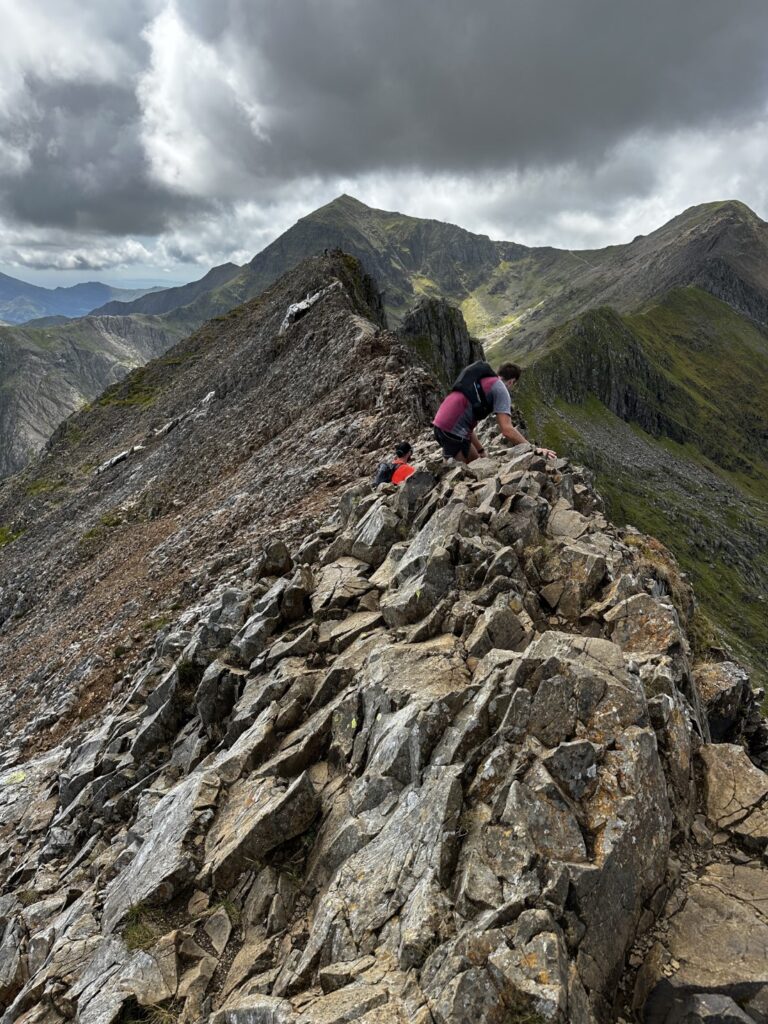











Another view of a recce of Crib Goch – where Sanna and I took on the ridge in not-so-great weather conditions.
Kit and Registration
The Dragon’s Back race has a strict and limited weight requirement for kit. You have to use two Ortlieb Dry Bags specifically for the race. A 59L bag is used for your camp kit, clothes for the week, and nutrition you’ll need for each day in the mountains. A limit of 15kg applies.
For each day, you’re allowed to place up to 2.5kg of supplies into a 10L dry bag which will be placed by the race volunteer’s at each day’s half way support point. You can then take anything out at this point to replenish or refuel.

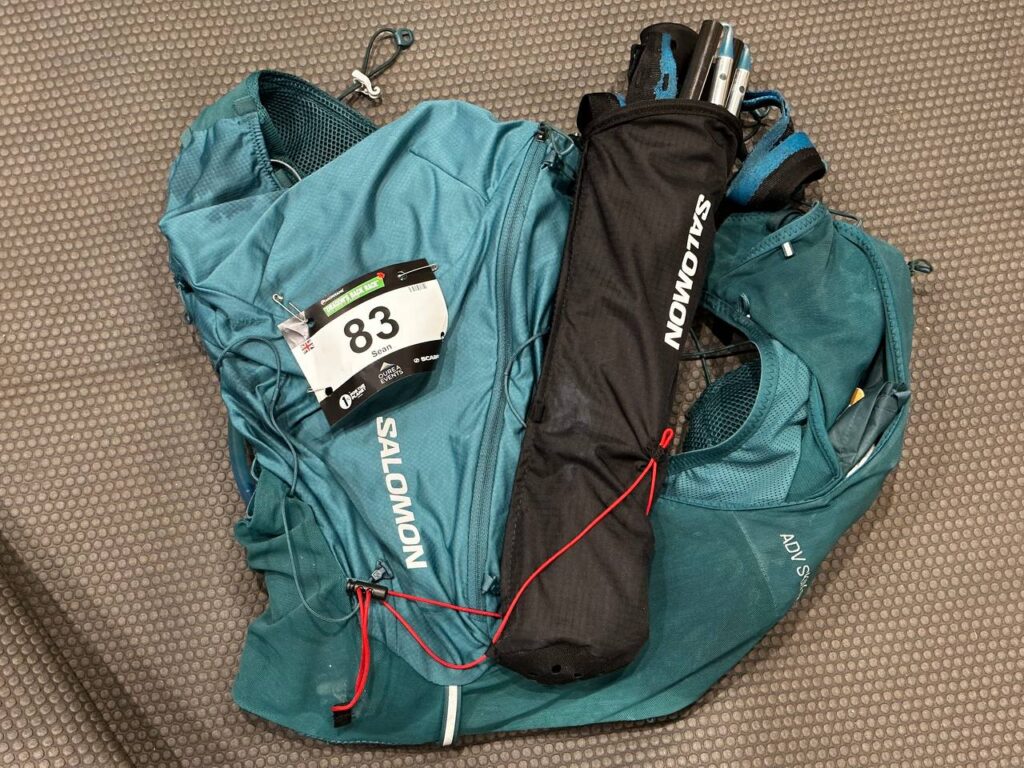
Collecting and refining all the mandatory kit requirements, and orchestrating the layout and packing of all this kit took many iterations. Here is how mine looked. Total weights were just very slightly under the limits on both bags.
I had running clothes for 4 x days (I would re-use kit for 2 days), clean, dry socks for each day, and 3 x pairs of shoes – different options for different terrain types. For camp kit, I had the mandatory items plus a few extras. This included obvious items such as sleeping bag, mat, plate, cutlery, to additionals such as protein powder for recovery, battery bank for recharging devices, to midge nets, first-aid kits, and more….
Each category of item in my main 15kg bag was organised into separate, smaller zip bags to keep some order to my camp gear. I also pre-packed each day’s nutrition into separate bags, ready to go each day straight into my running pack each morning.
Registration was on the Sunday (the day before the race start in Conwy, North Wales). Ben, Sanna, and myself all met up to register and attend the mandatory race briefing. Cassie, Ben’s wife was kind enough to help ferry and transport Sanna and I from registration to our AirBnB accomodation, and also fetch us again at 5am on race morning.
At registration had our kit checked and could optionally ‘check-in’ our main bags too if we liked, instead of worry about it on race morning.
There was a meal for everyone that evening at registration which was great – one less thing to worry about the night before!
Day by day summary of the Dragon’s Back Race
I don’t want this blog post to be too long, so I’ll summarise each day from my perspective briefly covering how things went, what sort of terrain you run on that day, as well as anything else I remember in terms of events or interactions with others.
Day 1 – Conwy Castle Start, through Northern Snowdonia / Eryri
Day one – 49km | 3800m
The start of the race is in Conwy Castle at the very top of Wales. This is the most technical of days. Extreme climbs, terrain with multiple sections requiring scrambling and full use of all four limbs to get up mountains, as well as sections where falling or losing your grip would lead to certain death (Tryfan and Crib Goch being two such places).
We started in Conwy castle, with an amazing atmosphere in the darkness of the early morning with a choir singing us off, and crowds in the castle cheering us all on.


Soon we were off, into the rapidly increasing heat of the day.
The weather this race week turned out to be a full-on heat wave. The temperature soon crept up and started taking it’s toll on just about everyone.


I ran with Sanna for much of the morning – we had a similar cadence and approach to pace, so it made sense. We stayed about 1 to 1.5 hours ahead of the ‘recommended’ timings for each checkpoint we passed.
There are strict cut-off times that you need to stay inside of to ensure you don’t get dropped from the full course race.
Around the time we started climbing Tryfan – a massive mountain near half-way on the day, I started to experience small bits of cramp in my calf muscles.
It didn’t occur to me that I might be starting to get dehydrated – I’m not sure why, as I was sweating bucket-loads. I pressed on though, but soon found myself starting to slow in my pace. After Tryfan and a bit of descent, you end up on the Glyders – a section of alien-like looking rock with lots of scrambling still required as you head down toward Pen-y-pass.
Cramp got progressively worse for me, and I found myself surrounded by many other runners being taken down by a similar fate. I had ramped up my electrolyte and salt capsule intake, and thought I was drinking enough, but by the end of the day it was clear I didn’t take in enough water.
At Pen-y-pass (a water checkpoint and support station before climbing up to the infamous Crib Goch climb and razor-edge ridge line), I drank about 2L of fluids over 30 minutes of rest. The support stop also had a small shop, where I bought an ice cream and some cans of pepsi. I filled my hat with ice cubes and popped that on my head too. The heat at this point was almost unbearable.
In my mind I was still determined to press on. So off I went up toward Snowdon, and the ascent to Crib Goch.
Arriving at Crib Goch, I began the first bit of the scramble up. There is a good 400 meters or so of climb to get to the top, and it’s pretty sheer.
My leg cramps had been getting worse though, and even spreading to other parts of my body. Stomach muscles, insides of my legs, and the bottom of my feet were beginning to cramp too.
Before I got too far up onto Crib Goch, I rang race control to get their opinion on whether or not it was safe to continue. I had been mentally pushing through the cramps and pain to keep moving forward, but my legs were now physically refusing to move further. As much as I wanted to continue mentally, I just couldn’t. Each step up was agonising. Even going down would trigger cramp, though not as bad.
About 1/3 of the way up Crib Goch, and with only 7km remaining of the day’s route (and still being about 30 minutes ahead of recommended times), I made the decision to pull out of the competitive race.
Race control instructed me to walk back down to Pen-y-pass, where I was able to get shuttled back to Day 1’s camp. Arriving at Pen-y-pass I found I was not alone. There was a large assembly of other runners who had similar issues to me.
Camp life and food
I’m throwing this section in-between the different day summaries to give an idea of what camp life and food is like on the Dragon’s Back Race.
Each day, the event organisers and volunteers (an army of people!) take down the entire camp, and move it to the next day’s camp location, ready in time for runners arriving at the end of the course for the day.
Camp was always in a flat meadow or grassy section next to a river of some sort at the end of each day’s route. It always had the same facilities and general layout, including:
- Tents (8 runners per tent, with 4 x compartments of 2 people each). There must have been about 30 tents in total
- Main marquee for eating, resting, socialising. This was a big tent with tables, chairs, and bean bags. It also housed an info desk area, where we could get info or help, find lost property, charge devices, and print out ‘dragon mail’ (a feature on the tracking website where members of the public could send those racing messages to be printed out here at this station).
- Toilets (of course)
- Drying tent – for hanging wet running kit
- Medical tent – medics, physio, and other assistance for those requiring it
- Catering tent – we picked up our meals, including breakfast, late afternoon post-running chips / soup, and evening meals (mains and dessert)
- Drinks tent – hot drinks and water available to all
- Washing up area – sinks for washing our plates and cutlery
- Main finish and start area with timing board and team to handle each runner’s timings and checkpoint printouts.
- Staff and volunteer camping area
- Note: there were no showers, excepting day 2’s camp


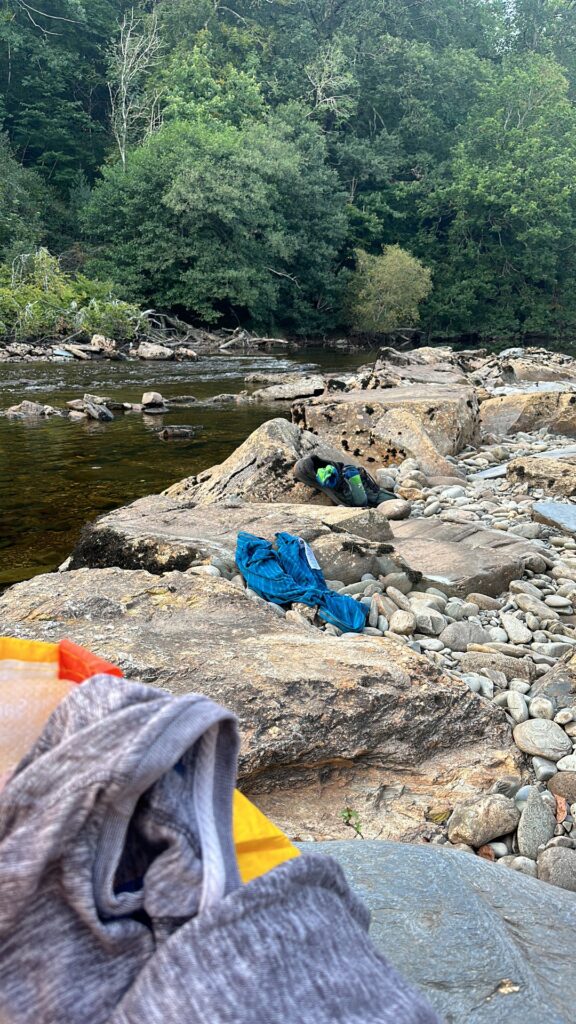


Did I mention that all food on the Dragon’s Back is either vegan or vegetarian only?
They also catered for other dietary requirements such as gluten free. The breakfasts and dinners were all supplied to us at camp on each of the six days by a professional catering team. The food was simply delicious!
Day by day – the remaining days
Continuing on with the daily summaries. As I had now dropped from the ‘competitive results and full-course race’, I now had the option to run what is called the ‘Hatchling’ course.
This means I could decide to run half days only if I wished (or even still stick to the full course days if I wished). I would now not be eligible for the main Dragon’s Back competitive results, or be able to get a full completion Dragon trophy.
With the cramp having very badly ruined and pulled my muscles, even continuing through the first night, my legs felt terrible. I wasn’t able to pee until noon the next day either – I was pretty badly dehydrated – and that was even after drinking at least another 4-5L of fluids into the night.
It was a good decision (physically) to pull out of the main race and continue on with Hatchling or half-days for a bit. Who knows what trouble I could have got into on the ridge of Crib Goch with my condition!
Day 2 – Southern Snowdonia / Eryri to Dolgellau
Day two – 59km | 3400m
I elected to do the Hatchling half day course for Day 2, starting at around noon. This allowed me to recover my hydration and electrolytes. I had my first pee since the day before at around noon – just in time for the start! Thankfully things appeared normal. My cramps had also subsided, but my muscles were aching from the stress the cramps had put on them. Even the muscles in my hands had been cramping up through the night!
Day 2 took us through the Moelwyns and Rhinogs – two gnarly mountain ranges in Southern Snowdonia. The terrain is still very mountainous in this region, with lots of technical climbs and scrambles a-plenty. There are also lots of pathless sections to run with no well-defined trail, and lots of boggy areas to navigate too.
Taking on the second half of the course (and day) meant that I got to run through the Rhinogs. Here is a view after I had ascended one side, come down into the valley below, and started my way up the other side:
The mountains of Wales are often inhabited by mountain goats. Here’s one that was watching me curiously as I sweated my way up the mountain.
A selection of photos from my day out in the Rhinogs:


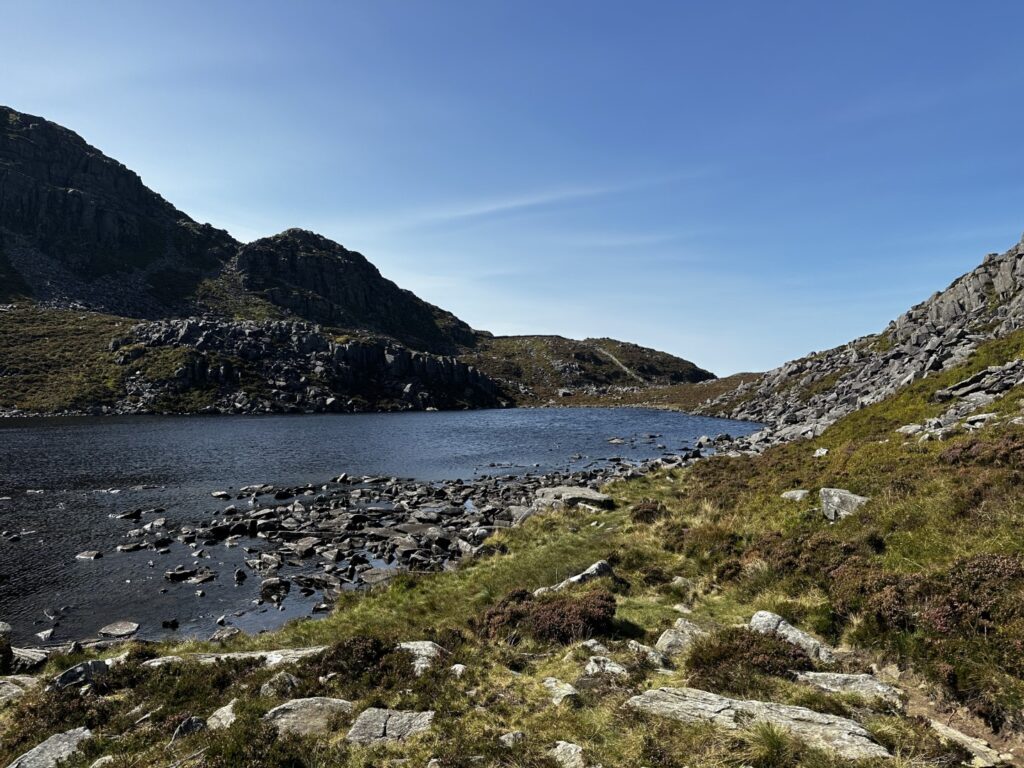



I soon found myself pulling away from the hatchling group that started in the afternoon, and spent some time on my own in the mountains.
One of the faster runners on the main course caught up with me (Tris / Tristan) and after some scrambles down and up the mountains we found ourselves paced similarly. My previously cramped muscles had warmed up a bit now and a breeze had picked up, allowing my pace to get back to normal levels.
Tris and I ran together for an hour or so passing two or three different checkpoints. In the later part of the afternoon he sped on ahead, with maybe 10km remaining of the day.
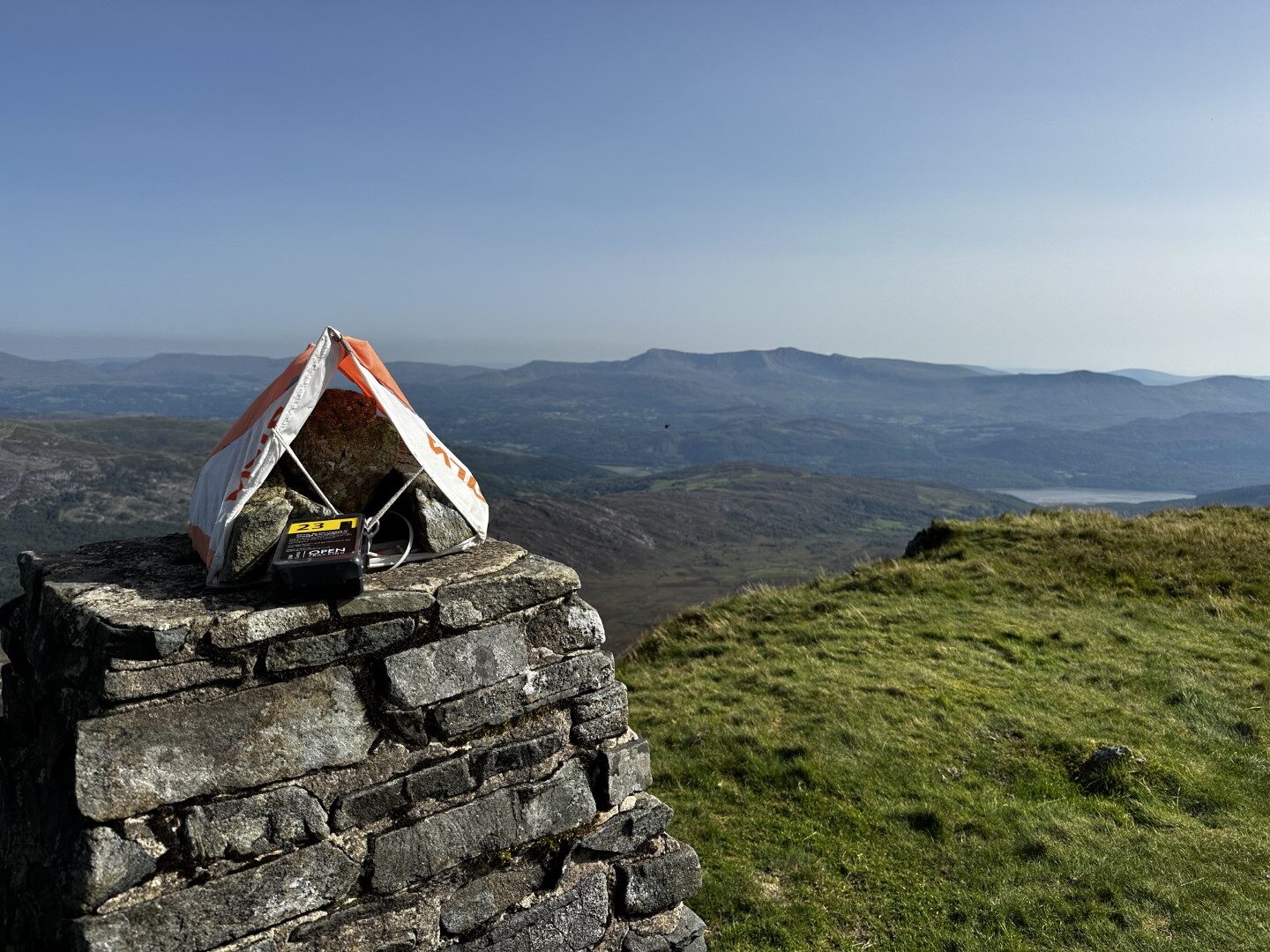


Off the mountains, I ran through a bit of a woodland, and then found myself on the road for the final stretch back to camp. My pace stabilised and I found a good cadence to run back in.
That late afternoon at camp, I re-fueled on two plates of chips, soup, as well as dinner and dessert. I felt like dehydration was no longer an issue at this point, and my body was feeling stronger with every passing hour.
Day 3 – Dolgellau to Ceredigion
Day three – 70km | 3400m
Another half day for me. I probably could have resumed full days at this point, but my spark was gone. As I was no longer in the running for a full course completion, or full finisher’s dragon trophy, I had no impetus or desire to do full days.
My legs felt strong. Sure the muscles were achy from the cramp, but physically otherwise I felt great. My feet were still in good condition and I knew I was trained up and prepared for six full days. However, mentally I was out of the race, and so I just couldn’t bring myself to endure the full-on hardships of each full course day.
I took the second half option of Day 3. These half days were still enjoyable in a way for me. I got to experience the amazing scenery and landscapes of the mountains, enjoy running and chatting with others, and another bonus, I could relax and enjoy camp life more.
Day 3’s course would have us leave Southern Snowdonia over Cadair Idris and head into the Cambrian Mountains of mid-Wales. As I was doing the second half, I started in the town of Machynlleth. Myself and other ‘Hatchlings’ were dropped off in the late morning where we had to wait for our noon start.
This meant we could visit shops, fuel up, and enjoy life a bit before starting out in what would turn out to be another swelteringly hot day.

Starting at noon had us climbing up into the mountains out of Machynlleth (today’s mountains would be kinder in terms of gradient).
There was just about no wind, and the sun was beating down on us all. This combination had me sweating profusely once again. It was extremely uncomfortable. The only respite I could find was to power hike the hills and steep climbs, in order to be able to run and therefore generate wind and air movement to cool my sweat.
I made my way to the front of the hatchling pack again, my speed was more intended to get through the day and out of the heat, rather than compete against others though. This time I stayed on top of my hydration. I had recce’d all of this section of the route and was familiar with it. About 2/3 of the way through I knew there was a mountain lake, and I intended to take a dip to cool off.
However, arriving there, I found a sign warning of blue / green algae and prohibiting any sort of swimming. In hindsight I should have just cooled off in the river I had followed up the mountain.
The climb up to this section was the worst terrain of the day (in my opinion). Almost pathless – the trail was very difficult to keep track of, and the grass was at least knee high or higher. Many sections of the barely visible track were littered with sudden gulleys and drops. This 1-2 mile section was hard work, and very risky in terms of potential ankle rolls.
After the lake there was another 200-300 meters of climbing to a checkpoint, from where the gradient began to ascend once again back toward camp.
Arriving at one of the final checkpoints I received a text message on my phone from race control – “Hello Sean, please be advised that we have not yet set up the checkpoint you’re about to get to – please continue on if you don’t see it”. It turns out I was quite ahead of their schedule and was one of the first runners to pass this point in the day.
Of course this partly because I had a ‘head start’ as a Hatchling, having been dropped off half way.
Soon enough I saw two figures ahead of me on the top where the checkpoint was meant to be, setting up the checkpoint flag and device that scanned our tags. Two volunteers who had run up the mountain from the other side to set this up.
I found it motivating for my pace to stick with them as they ran back down to camp. Soon enough I was loving life once again bounding down the hills and mountain back toward camp. Running meant wind generation, and wind on my face was welcome in the still very hot conditions.
Arriving back at camp I was greeted by the finishing team with an ice lolly and fresh water. Running back at brought my core temperature up quite a bit and I could tell my heart rate was elevated because of the heat.
I went straight to the river to cool off, collecting one of my camp bag stash ‘prized posssions’ – a can of coke with me. I floated the can of coke in the river with me to cool down, and spent a good hour or so relaxing.
Day 4 – Through the Elan Valley
69km (43 miles) | 2300m (7,546ft)
Motivation was still not present for full days – there was no real reason for me to run them now. So I again elected for a half day course, taking the earlier morning session this time.
I was up early at 4:45am to pack my camp kit and gear back up (a daily routine for everyone) and hand it in for transport to the next camp.
Breakfast and morning routine was completed and I was ready to go at 6am, having completed the usual mandatory kit check and gear weigh-in.
Breakfast for me was always a combination deal. Tea, hydration + electrolytes, cereal, followed by beans and potato hash-browns.
The initial climb out of camp is one I was familiar with, having recce’d this section with Ben before. It’s a good 300 meters or so of pretty steep elevation, which then evens out onto some difficult to run boggy sections.
Most of this first half section of day 4’s course is actually quite challenging terrain. You run on fell-like terrain, with long grass, wet boggy sections, and thousands upon thousands of grass ‘tussocks’ – tufts of long thick grass that have your feet and ankles moving and slipping all over the place.
There are some road sections to run too, which I personally found a good relief from all the uneven trail (and pathless trail!)
The weather was cooler today, thankfully. I found myself in a bit of an anti-social mood though, and mostly kept to myself as I navigated the half course for the day.

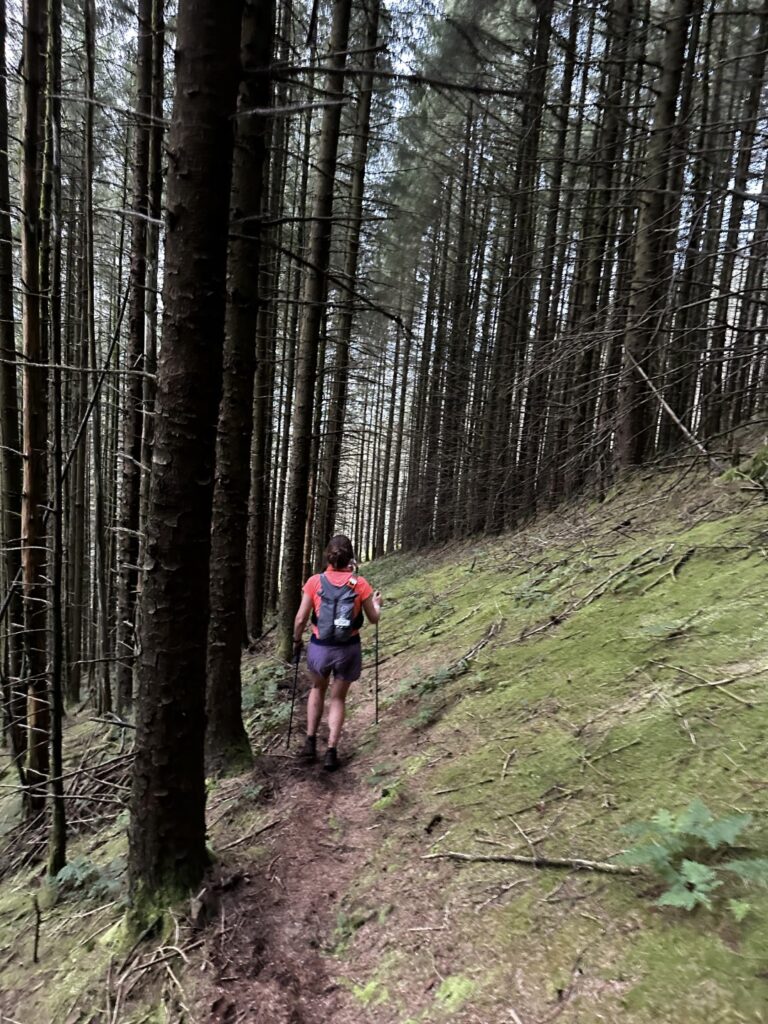
Running into the half-way point near the Elan Valley visitor center, I sat down and had a chat with some of the other runners, either stopping here for water and drop bags (on the full course) or the other Hatchlings such as myself.
I found that many people (full course and Hatchlings) were struggling with foot issues after the day’s uneven, wet terrain. Some people were nursing blisters on the sides of their feet from all of the grass tussock running. Thankfully my feet were still in good condition though.
As I had the freedom to choose, I decided to walk down to the Elan Valley visitor center – a 5 minute walk to a couple of cafes. I enjoyed my first proper coffee of the week here, as well as a couple of ice creams, hot pie, and a coke or two. Cassie (Ben’s partner) also happened to be here waiting to see Ben run through the checkpoint, and soon we were joined by a bunch of other Hatchlings – Graham, and some others.
We all enjoyed the luxury of the shop and cafe whilst waiting on our lift back to camp.
Day 5 – Into the Bannau Brycheiniog (Brecon Beacons) National Park
70km (43.5 miles) | 3200m (10,499ft)
Day 5 is one of the toughest days in my opinion. Though not as technical as some of the first three days, you still have to navigate some difficult terrain, over a long distance, with lots of accumulated elevation, with the previous 4 days of fatigue in your legs! There is a fair bit of road running in the initial 1/3 before you get to the town of Llandovery (as well as just afterward), but then it mostly becomes fell-style terrain as you get into the Carmarthen Fans area and beyond.
Thankfully, as a hatchling, I didn’t have the full scope of these problems to contend with! Added to that, the event organisers (adapting to the heat wave and conditions as the week went on) added a third hatchling option – 10 miles / 16 km of the final route.
This happens to be my most favourite section of day 5, so it was perfect for me. We would start near the Storey Arms car park, below Pen-y-fan (the highest mountain in South Wales), climb up to the top of this mountain, and then run the ‘horse shoe’ section of the surrounding mountains, before descending down toward a river and camp.
The heat was once again intense. But I was prepared. A shorter route, plenty of fluids in my pack, and full application of sun-screen, plus my dorky Saharan hat.
The hatchlings all lined up at the start and soon we were off, climbing up to Pen-y-Fan.
I powered up the mountain in record time. My energy levels were peaking and I felt great. Once at the top, I pretty much ran the entire horse shoe, which included a chunky accumulation of elevation.





It only took me 2 hours before I arrived back in camp, including a couple of quick dunks in the last river before camp. I was ahead of the full course runners and the hatchlings of the three hatchling variations. I felt great. My favourite day of them all!
At camp I took my time to wash in the river and enjoy copius amounts of snacking. As hatchling and full course runners arrived, I enjoyed chatting and catching up with many, especially Jay – one of the hosts of the trail and error podcast whom I met that day.
Coming into camp early, I had a long time to rest, recover, and re-fuel. The final day, day 6 was next to come, with the final stretch to Cardiff Castle ahead of us.
Day 6 – To Cardiff Castle
63km (39 miles) | 1300m (4,265ft)
For day six, I had decided to run the full course / length. By now my body was feeling great. Most of the muscle soreness from Monday’s cramping had dissipiated, and it just felt ‘right’ to run the full day into Cardiff Castle.
After the usual morning routine of packing kit up and having breakfast, Ben and I set off together from camp at around 07:06am.


Ben was still running the full course, as was Sanna at this point – I was really happy that they had made it to day 6, as it’s pretty much a guarantee that you’ll finish if you make it to this day. Even though there is still 63km of running to cover, this day is far easier in terms of the terrain and elevation to cover. The hills are much more ‘rolling’ and there is ‘only’ 1300 meters of total elevation in the day.

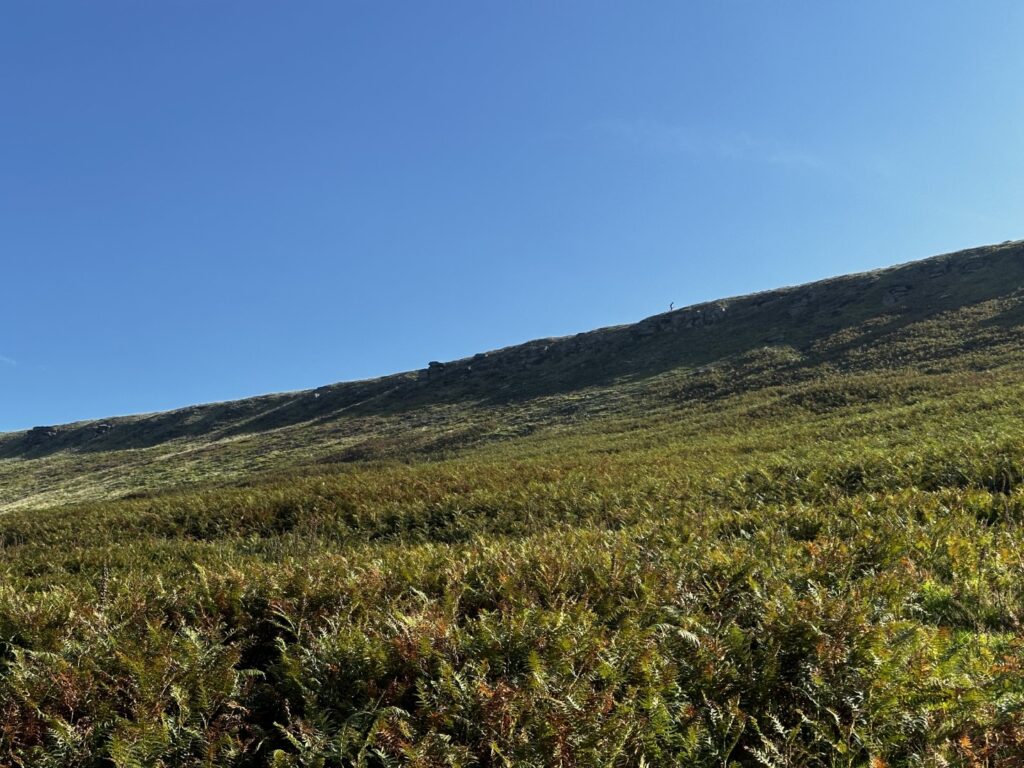
Ben and I ran for most of the morning together till we got to the half-way checkpoint. He had massive support from his running club friends (Cardiff / CDF) who were following him along all the way in to cheer him on the route. I enjoyed a lot of this support from them too – they’re an awesome bunch. However, it felt right to leave Ben at this point as they were primarily there for him, and I had my own support waiting for me at the finish line – my wife, Carmen.
The heat was really hitting hard by midday though, so at the half way support point I enjoyed a spray down with water and a coke I had stashed in my drop bag.
The CDF runners gang were seriously impressive with how they mobilised though. I caught at least two or three of them at every major town or intersection along the remaining 16 miles of the course. Huge shout-out and thanks to them not only for supporting Ben with their cheers and high-fives, but for the support they gave me too – it really was motivating. In particular I remember seeing Cassie, Wilf, and Amy and various points on the way to Cardiff.
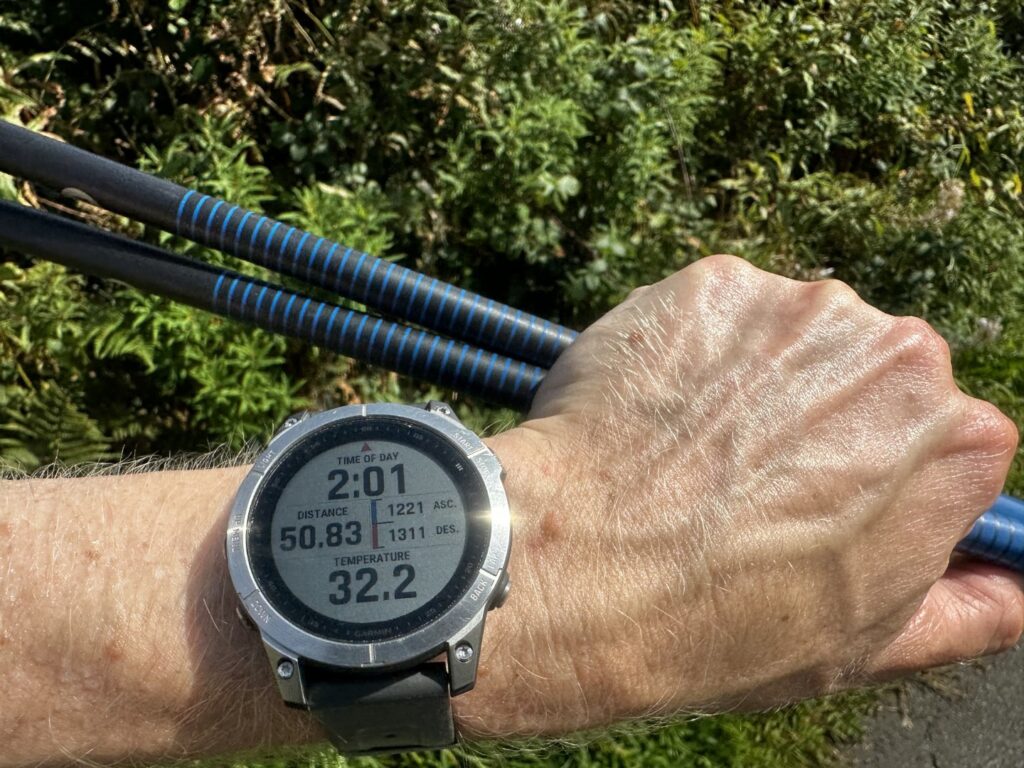
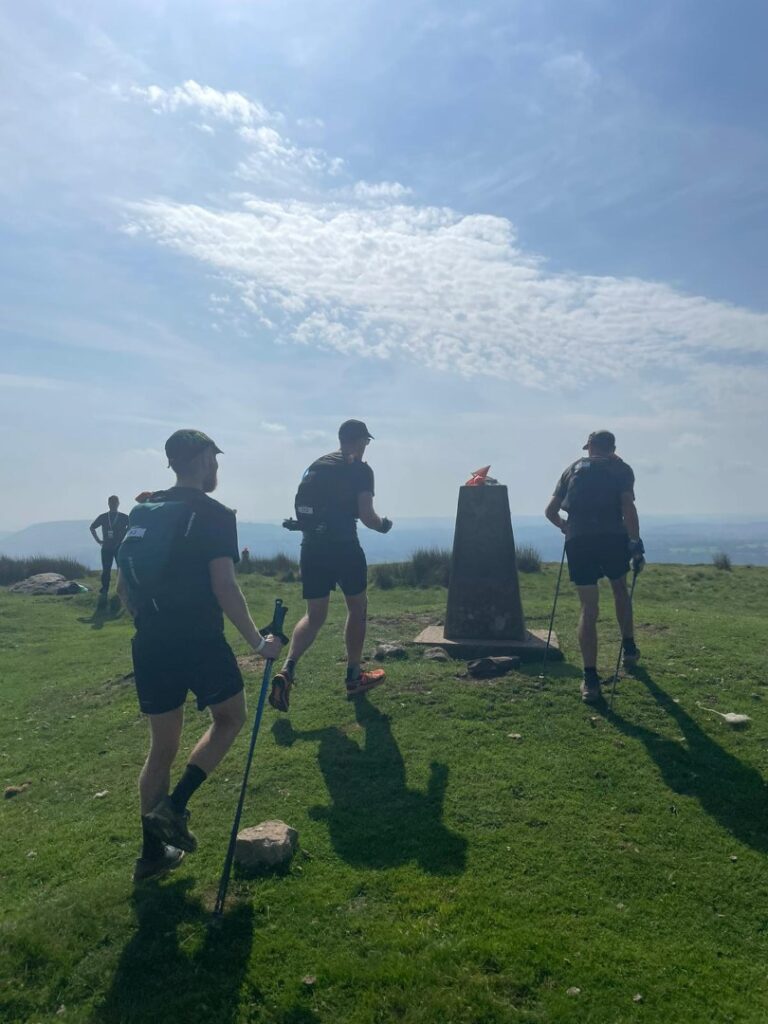
The day six course also passes through a number of small towns on the way to Cardiff, and this meant we were able to buy goodies from any shops we passed by. I made two stops – one for a red bull, a coke, and an ice cream, and a second stop after the support point once again. I really went all out at this second stop – two ice lollies (one in each hand), a ice cold orange juice (mixed straight into my 2L salomon water bladder), a red bull, and another coke.
I set off again after the shop stop up the hill wielding an ice lolly in each hand, trying to get them down before they melted.
The long ascent took me up towards the Rhymney Valley Ridgeway. At the top I opened up my can of red bull, gulped it down and enjoyed the hit of caffeine and sugar, taking me onward toward the finish line.
There was one more water support point stationed at a pub about 10 miles before the finish. Here I stopped once again and was watered down by the brilliant Caz and Sy (two cheerful and fun volunteers). Caz is actually local to me in Pembrokeshire and is the organiser and race director of the brilliant Preseli Beast fell race!
I used the pub to ingest two more cokes loaded with ice, purchased at the bar. I also met up with Ieuan who had joined up to help / volunteer and was handing out ice lollies to all runners coming through (thanks bud, I needed that!)
Soon enough Cardiff Castle was within striking distance. The final stretch is very flat and easy running through various parks as you approach the castle. A stark contrast to all the rest of the Dragon’s Back route that lay before!


My finish at the end of day 6, Cardiff Castle:
Thanks to Cassie for recording this one as Carmen moved around to the finish line to intercept me.
Final thoughts and conclusion
So the race didn’t go to plan for me. I have never struggled with heat before, but Monday’s conditions really took me by suprise (as they did for many others). I learned that even though I’ve never really ever struggled with cramp, I’m still vulnerable if I don’t stay on top of my hydration.
A critical error I made was packing my 1500mg electrolyte tablets into my main camp bag which I checked in on Sunday – meaning I couldn’t access these and have them before starting on Monday morning. I won’t let that happen again – I’ve come to realise and accept that this error may have been what cost me the entire race. I’m a heavy sweater, and pre-loading this large dose is something I do religiously every time I run ultra distances.
The week was still a great success for me. I learned so much about the Dragon’s Back Race – camp life, personal admin, how the race operates, how logistics work, as well as little optimisations and techniques to deal with conditions on a full week multi-day race.
I’ll be back to take on the full Dragon’s Back Race again in the future. Most likely not next year, but perhaps the year after. Training and discipline is full on to take on the Dragon’s Back Race. It was tough going this last year, but I felt fully prepared and capable to complete the race, if it were not for Day 1’s dehydration issue.
Huge thanks go out to my family for allowing me the time to train and explore the route through the last year, as well as the massive cost that went into entry, gear, and days out exploring.
Also a big thanks to my coach, Jack Scott of Trailjackcoaching for preparing me both mentally and physically for this immense challenge. I know I would have conquered this race if we hadn’t hit a heat wave that week. Despite the hit of dehydration and muscle cramps, I got stronger through the week and absolutely demolished the hatchling half-day courses, feeling strong at the end of each successive day.




Oh my, Sean, where to start?!
First of all, you made a smart decision. It was a tough one with only 7km to go and with being 30 minutes ahead of plan, but it probably saved your life.
At your level of fitness and with your preparation, you could have easily crushed this course, as you demonstrated on the Hatchling courses.
I’m really sorry that the race didn’t go as you intended. Honestly, who would have thought that it would be so hot?! And that a seemingly minor electrolyte oversight would have such an impact?
Your situation reminds me of last Saturday, an unusually hot day in Zurich. A 29-year old friend was doing a half-marathon. He was a similar build to you and is super fit, although not a runner. One hour in and he was suffering cramps and could hardly walk. Maybe big, strong athletes are more prone to this issue?
In any case, I know that you will smash it next time. The event will still be around in 2025 and now you’ve had the full recce!!
Thanks for this fabulous report and the photos, it was an amazing read!
A painfully close yet far situation being that close on day 1 indeed! Thanks Catrina.
I hope your friend recovered well from the cramping and heat. It really can be a showstopper. I’m thankful for the learnings that came from it though. We had similar heat on the day of the Ultra-Trail Snowdonia (UTS) race I did earlier this year, though I managed it so well – the main difference was I had been taking those large doses of electrolytes each day leading up to the race for a few days. That’s the only difference I can think of here, so I’ll be ensuring I stay on top of that next time. I’m a heavy sweater so its an important thing to watch out for me. If you’re curious, there is an online ‘salt test’ I used a couple of years ago by Precision Hydration that helped me figure out what electrolyte doses I should use – they massively helped my performance. Might be useful for you in future races (though I wouldn’t change anything this close to Berlin Marathon!)
Yes, 2025 will be good I’m sure. I know the entire route from the top to the bottom of Wales and have valuable insight into how everything else around the race works.
Cheers!
Thanks for that Sweat Test tip!
I just told my friend about it (the one who suffered from cramps last Saturday). They don’t offer the test in Switzerland but he works in the medical field, maybe he can find something similar.